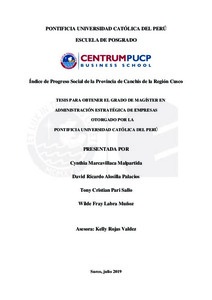| dc.contributor.advisor | Rojas Valdez, Kelly | |
| dc.contributor.author | Marcavillaca Malpartida, Cynthia | |
| dc.contributor.author | Alosilla Palacios, David Ricardo | |
| dc.contributor.author | Pari Sallo, Tony Cristian | |
| dc.contributor.author | Labra Muñoz, Wilde Fray | |
| dc.date.accessioned | 2019-10-06T19:43:15Z | |
| dc.date.available | 2019-10-06T19:43:15Z | |
| dc.date.created | 2019-07 | |
| dc.date.issued | 2019-10-06 | |
| dc.identifier.uri | http://hdl.handle.net/20.500.12404/15115 | |
| dc.description.abstract | El desarrollo del presente trabajo de investigación se basa en la medida del índice de
progreso social de la Provincia de Canchis y sus ocho distritos tanto de sus centros poblados
urbanos como rurales. Fue la primera vez que se realizó la medición del índice de progreso
social de la provincia de Canchis, lo que a la vez se convierte en una oportunidad para poder
realizar comparación frente a futuras mediciones y tener indicadores a través del tiempo. La
zonificación se realizó conservando la división política de la provincia de Canchis, por lo que
el cálculo del índice se realizó por distrito, con la finalidad de que cada distrito tenga un
indicador que muestre la situación actual y real acerca del progreso social.
El índice de progreso social de la provincia de Canchis obtuvo un puntaje de 35.11,
ubicándolo en el nivel de progreso social muy bajo y el índice de progreso social regional del
Cusco es de 50.77, puntaje que lo ubica en el nivel de progreso social bajo, la analogía de
estos puntajes indica que existe diferencia, para entender la razón de esta diferencia
detallaremos los resultados de las dimensiones: Respecto a necesidades básicas humanas
39.84 puntos para la provincia de Canchis y 50.79 puntos para la región del Cusco. Respecto
a Fundamentos del bienestar 34.65 puntos para la provincia de Canchis y 57.56 puntos para la
región de Cusco. Respecto a oportunidades 30.84 puntos para la provincia de Canchis y 43.95
puntos para la región del Cusco. En las tres dimensiones la región del Cusco mantiene ventaja
sobre la provincia de Canchis, la mayor diferencia está en la dimensión de Fundamentos de
bienestar, por lo que se debe duplicar el trabajo para mejorar los indicadores de acceso a
conocimientos básicos, acceso a la información y telecomunicaciones, salud, bienestar y
sostenibilidad en la provincia de Canchis. Finalmente los puntajes del nivel del progreso
social por distrito fueron: Para Sicuani 33.84, Tinta 41.96, Checacupe 33.32, Combapata
28.42, Maranganí 35.01, Pitumarca 30.08, San Pedro 42.94, San Pablo 33.14, lo que
evidencia dispersión entre los valores por distrito. | es_ES |
| dc.description.abstract | The development of this research work is based on the measurement of the Social
Progress Index of the Province of Canchis and its eight districts, both in its urban and rural
population centers. It was the first time that the measurement of the Social Progress Index of
the province of Canchis was made, which at the same time becomes an opportunity to be able
to compare against future measurements and have indicators over time. The zoning was done
while preserving the political division of the province of Canchis, so the calculation of the
index was done by district, with the purpose that each district has an indicator that shows the
current and real situation about social progress.
The Index of Social Progress of the province of Canchis obtained a score of 35.11,
placing it at the level of social progress very low and the index of regional social progress of
Cusco is of 50.77, a score that places it at the level of low social progress, the analogy of
these scores indicates that there is a difference, to understand the reason for this difference we
will detail the results of the dimensions: Regarding basic human needs 39.84 points for the
province of Canchis and 50.79 points for the region of Cusco. Regarding Foundations of
welfare 34.65 points for the province of Canchis and 57.56 points for the Cusco region.
Regarding Opportunities 30.84 points for the province of Canchis and 43.95 points for the
region of Cusco. In the three dimensions, the region of Cusco maintains an advantage over
the province of Canchis, the biggest difference is in the dimension of Fundamentals of wellbeing,
so work must be doubled to improve indicators of access to basic knowledge, access to
information and telecommunications, health, welfare and sustainability in the province of
Canchis. Finally the scores of the level of social progress by district were: For Sicuani 33.84,
Ink 41.96, Checacupe 33.32, Combapata 28.42, Maranganí 35.01, Pitumarca 30.08, San
Pedro 42.94, San Pablo 33.14, which shows dispersion among the valor by district. | es_ES |
| dc.language.iso | spa | es_ES |
| dc.publisher | Pontificia Universidad Católica del Perú | es_ES |
| dc.rights | info:eu-repo/semantics/openAccess | es_ES |
| dc.rights.uri | http://creativecommons.org/licenses/by-nc-nd/2.5/pe/ | * |
| dc.subject | Indicadores sociales--Perú--Canchis (Cuzco : Provincia) | es_ES |
| dc.subject | Indicadores económicos--Perú--Canchis (Cuzco : Provincia) | es_ES |
| dc.subject | Investigación cuantitativa | es_ES |
| dc.title | Índice de progreso social de la provincia de Canchis de la región Cusco | es_ES |
| dc.type | info:eu-repo/semantics/masterThesis | es_ES |
| thesis.degree.name | Magíster en Administración Estratégica de Empresas | es_ES |
| thesis.degree.level | Maestría | es_ES |
| thesis.degree.grantor | Pontificia Universidad Católica del Perú. CENTRUM | es_ES |
| thesis.degree.discipline | Administración Estratégica de Empresas | es_ES |
| renati.advisor.dni | 41038596 | |
| renati.advisor.orcid | https://orcid.org/0000-0002-4866-1671 | es_ES |
| renati.author.dni | 44694585 | |
| renati.author.dni | 45693986 | |
| renati.author.dni | 42600694 | |
| renati.author.dni | 42429134 | |
| renati.discipline | 413307 | es_ES |
| renati.level | https://purl.org/pe-repo/renati/level#maestro | es_ES |
| renati.type | https://purl.org/pe-repo/renati/type#tesis | es_ES |
| dc.publisher.country | PE | es_ES |
| dc.subject.ocde | https://purl.org/pe-repo/ocde/ford#5.02.04 | es_ES |






